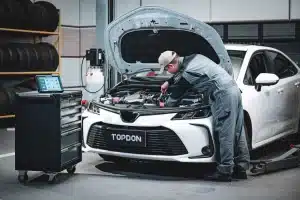Shortage of Auto Technicians Has Dealerships Taking Action
If the sticker shock faced by car shoppers in the showroom isn’t enough to provoke a cardiac episode, a visit to the dealership’s service department might do the job. That’s where a tire-kicking customer is likely to spot the sign announcing labor charges upward of $125 an hour, a rate typical in cities and at the low end for luxury brands.
Besides chest pains, the number might also elicit a gasp of realization: “That’s way more than I earn.”
It’s true that a mechanic wielding wrenches is not paid that hourly rate — the shop’s cash flow must cover sophisticated diagnostic tools and contribute its share toward the dealership’s prime real estate. But top-level technicians in the field can earn $100,000 a year after achieving master mechanic status and five years of experience, said Robert Paganini, president of the Mahwah, N.J., campus of Lincoln Technical Institute.
So, it would be logical to conclude, applicants must be banging on dealership doors for those jobs.
Not quite: It’s the dealerships and auto manufacturers banging on doors, eagerly seeking out candidates at job fairs, trade schools and events for veterans. The shortage of qualified technicians is so acute that a year ago, BMW of North America began its own recruiting program, making its pitch to students at postsecondary technical schools and career fairs. While that may be a common practice for multinational corporations, it’s unusual in that the job openings will be at independently owned BMW franchises.
The shortfall of automotive technicians is not new, but as vehicles have grown more computerized and vocational programs have disappeared from high schools, the situation has become more urgent. No longer is the career path a matter of looking over the shoulder of a patient mentor. Advancing in the profession demands digital skills — a diagnostician who can solve puzzles without physical clues, like an engine bearing that knocks or an axle shaft that vibrates.
John Fox, director of Fiat Chrysler’s Performance Institute, said that the automaker’s United States dealerships could absorb 5,000 technicians over the next two years, having hired 3,000 in the last two. Numbers of that scale give Mark Davis, automotive programs manager at Seminole State College in Sanford, Fla., confidence that his estimate of technician shortfalls — more than 25,000 at American dealerships over the coming five years — is actually quite conservative. Worse yet, there may not be enough training institutions in the country to keep up, Mr. Davis said.
It’s a situation that cannot be ignored. With competition for car buyers cutting into their profits, dealers’ service departments have grown into a vital income source. According to a 2016 report by the National Automobile Dealers Association, 266,000 technicians are employed to perform mechanical and body repairs. Last year, customers at dealerships in the United States spent $18.9 billion on labor charges in the service department. Warranty work, whose costs are picked up by the automakers, accounted for another $9.6 billion.
All along, car companies have operated training programs to convey the specialized repair information peculiar to their new models. But that continuing education is intended to update experienced mechanics. To replenish the entry-level ranks as technicians change jobs or retire — turnover runs as high as 20 percent a year — automakers need to start at a more basic skill level, expanding the range of their own programs and partnering with private technical schools to reverse the technician deficit.
Enrolling suitable recruits is not easy.
“There’s less of a mechanical interest and understanding among young people,” said Gary Uyematsu, national technical training manager at BMW of North America, noting that the biggest hurdle in hiring is the difference in basic skills. “They are not hands-on. Mechanics used to start with some gas station experience. Now the experience a person gets working at a gas station is selling slushies.”
With a traditional source of mechanics largely gone, automakers have had little choice but to take the initiative.
Fiat Chrysler’s approach to bringing in new technicians takes the form of what is now called the Mopar Career Automotive Program. Begun in the 1980s, it operates in conjunction with community colleges and trade schools. Students are eligible for internships, which enable them have an income and gain workplace experience while still in school. There are now 80 affiliated programs, with about 4,000 students working toward certification on Fiat Chrysler products in a 12- to 18-month program or a two-year associate degree
The tuition, according to Mr. Fox of Fiat Chrysler, is equivalent to the cost of one year at a four-year public college. “On completion of the courses, a student has achieved the first two of four levels of expertise,” he added, preparing him or her for a service department position.
BMW, whose vehicles are loaded with electronic technology, has been especially ambitious in its efforts to keep dealerships afloat and car buyers on the road. At the North American headquarters in Woodcliff Lake, N.J., where one of five BMW national training centers is housed on a suburban campus, students in the Service Technician Education Program do both textbook and hands-on mechanical work in combined classroom workshops.
The program, known as STEP, has graduated more than 3,500 students since it began in 1996, and does not charge students tuition; costs are covered by the dealership that hires them. A 16-week BMW-specific course prepares students, who are chosen from the top 10 percent of their class in a postsecondary automotive training program. About 400 students complete the program each year, and 94 percent are placed in dealership jobs, Mr. Uyematsu said.
While fundamentals like engine and transmission repairs are taught, some 90 percent of the instruction deals with electronic systems. The typical path of a graduate is to start as a maintenance-level technician whose duties include tire service, wheel alignments and programming electronic features; after six months to a year, a move to a position as a line mechanic is typical.
BMW is among several automakers with programs to recruit technicians. But finding suitable recruits is not easy. “There’s less of a mechanical interest and understanding among young people,” a BMW official said.
One of the most common misunderstandings about the technician’s job is the role of the computerized repair systems, according to Mr. Uyematsu. “Diagnostic equipment does not tell you what’s wrong,” he said. “It’s just a tool, and a diagnostician needs to interpret the messages.”
Lincoln Technical Institute, a nationwide chain that offers both automaker-affiliated courses and student-funded instruction, offers a curriculum of general automotive instruction (in addition to other technical fields like heating and air-conditioning systems) as well as dedicated programs with automakers like Fiat Chrysler and Audi. Lincoln’s students, Mr. Paganini said, are typically two years out of high school and have been working at a job that had limited career opportunities.
Lincoln educates them in both the mechanical and electronic systems, but it also emphasizes soft skills in each class. This is a reflection of the changing environment at repair shops, where increasingly, customers want to talk directly to the technician. The automotive program typically places 60 percent to 70 percent of graduates in new-car dealerships, with other graduates electing to works for tire and parts chains like Pep Boys or Midas.
More recently, Lincoln has added programs to help reverse the loss of high school instruction that was the first step for many career technicians. In this role reversal, local high schools have contracted to send students for part-day classes at the Lincoln facility, where they can complete six of the 13 study units offered in the full-time program.
Providing career paths in skilled trades is valuable for young people who may be technically adept but not especially interested in conventional paths.
Sebastian Torres, 19, of Tarzana, Calif., fits that description. A student in BMW’s STEP classes in New Jersey, he attended Universal Technical Institute for a year before coming connecting with the BMW program. It was, judging by his comfort in the surroundings of disassembled engines, a logical choice: “I knew as a sophomore I didn’t want college,” he said.
That aligns with what Mr. Davis of Seminole State College sees as the solution to the technician shortage.
“Potential students need to be shown that they have a viable career path if they pursue postsecondary training,” Mr. Davis said. “Training new technicians can be costly. However, not having trained technicians can be even more costly.”
Article posted in The New York Times
FRED R. CONRAD writer & photographs


